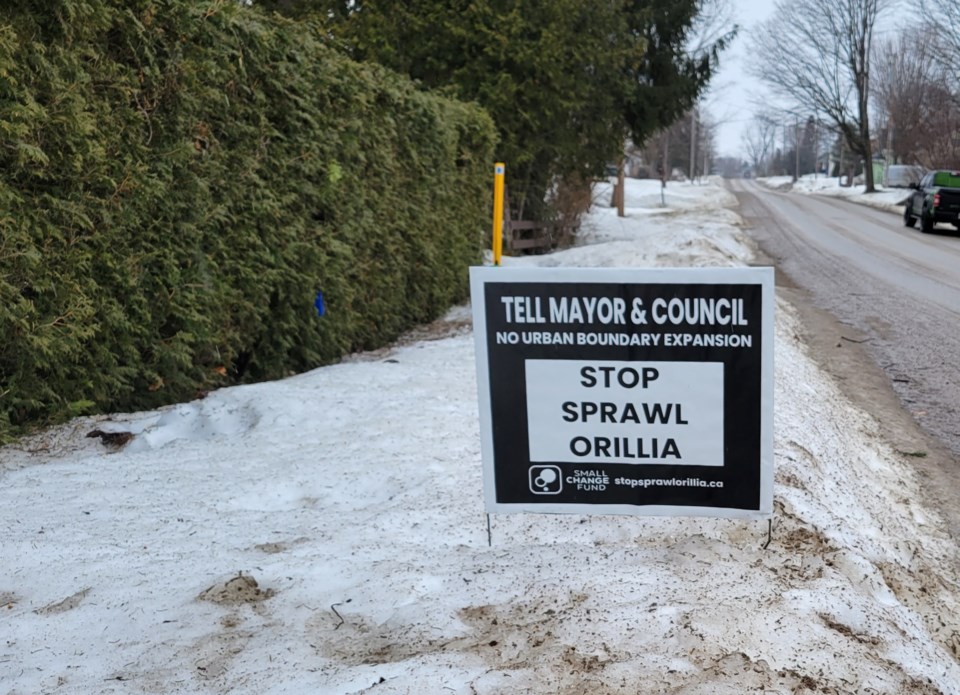Council committee has approved an additional $50,000 to explore the possibility of higher intensification targets and to reconsider the required lands for boundary expansion, following considerable pressure from the community over the past several months to reduce urban sprawl.
According to the province’s growth plan for the Greater Golden Horseshoe, the city must be able to accommodate 49,000 people and 26,000 jobs by 2051.
A 2021 report by consulting firm WSP stated the city needs an additional 380 hectares of land to accommodate the growth, noting that — without expansion — the city’s land supply for housing would run out by 2030.
The proposed expansion would meet a variety of needs, including housing, employment lands, and potential lands for a new hospital.
However, Stop Sprawl Orillia, a grassroots organization formed in February to rally against boundary expansion, cited sustainability and affordability issues that would occur by expanding city infrastructure and building on agricultural or ecologically sensitive lands.
A March 3 inquiry motion by Coun. David Campbell called for further consideration of increasing intensification targets, as well as an update to the city’s ongoing technical land evaluation. On Monday evening, council committee voted in favour of exploring increased intensification further.
Council members were sympathetic to citizens’ concerns.
Coun. Ted Emond was impressed by the number of citizens engaging council on this issue.
“I’m impressed by the fact that I’m hearing from young people who are concerned about the future of our city, the future of our country, the future of our climate, (who) express very passionate and very articulate arguments in favour of our council considering options other than the ones we have been pursuing,” Emond said.
However, members of council also pointed to the need to balance intensification with boundary expansion, and the need to protect the character of the city.
“I’m actually quite sympathetic with the planning notion that there is a character and it really needs to be protected,” said Coun. Tim Lauer. “I think this is the way to go about it, to find out exactly how (it affects that).”
The mayor echoed those sentiments.
“I believe that there isn’t a person around this council table that doesn’t understand or doesn’t recognize the value of intensification,” said Mayor Steve Clarke. “It really is imperative that we find that right balance between minimizing expansion and maximizing intensification without ruining the character of individual neighbourhoods.”
Clarke also highlighted the fact that the city has exceeded previously mandated intensification targets.
“In 2008, or thereabouts, (there was) a mandate by the province that required us to accommodate 40 per cent of our growth through intensification,” he said. “The good news is Orillia, over the last number of years, achieved 50 per cent or slightly higher, and that’s great.
“Unfortunately, the downside is that we’ve eaten up some of that land with intensification that we could have intensified with going forward.”
Madeleine Fournier, one of the founders of Stop Sprawl Orillia, said Tuesday she is happy with council’s decision to investigate intensification further.
“This is definitely Hurdle 1 of the whole Stop Sprawl Orillia movement,” she told OrilliaMatters. “It’s been amazing. The community has really come through.”
She has been impressed with the community’s engagement, with the movement gaining hundreds of followers on social media and ‘Stop Sprawl Orillia’ signs popping up on lawns across the city.
“One of the most important parts, to me, is that young people are writing to council and getting involved because climate change will affect young people the most and the worst in the future,” she said. “It’s been really impactful having young people raise their voices about our future.”
However, Fournier said she is disappointed Monday’s decision will not look into intensification for employment lands.
“Unfortunately, (the consultants) are only looking at more intensification for the residential and community lands.
“As it stands, no matter what, the boundary will still have to be expanded by about 56 hectares for employment lands, so we’re looking to get a councillor to raise a motion at another council meeting to look at intensifying employment lands further.”
Decisions made at Monday’s council committee meeting are subject to ratification at a later council meeting.
The $50,000 in approved funding will be used for ongoing work on the city’s land needs assessment, as well as employment and intensification strategies, and will increase the studies’ costs to $135,736.
Along with the additional funding, council moved to begin working toward a ‘made in Orillia’ set of planning principles to manage growth, and has asked Clarke to write a letter to the province requesting that the city’s built boundary be updated to reflect expansion that has taken place since 2008.
